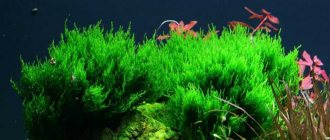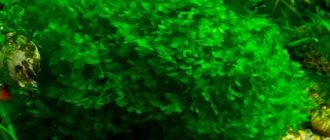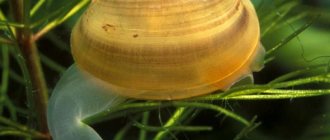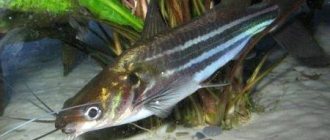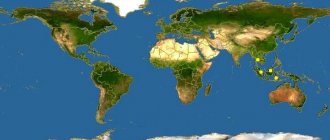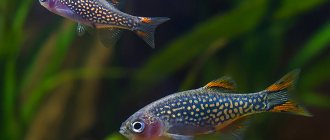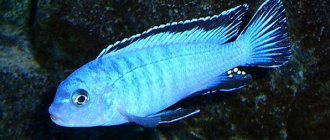The needle-shaped leaves grow up to 1 cm in length and 1 mm in width, and in the light the leaf blades give off a silvery appearance. Mayaka river has long but weak roots, on which many buds can be found.
The roots of Mayaka river can reach 50 cm in length.
When kept in good conditions, the plant forms dense thickets, and over time the owner can obtain flowering thickets. At the ends of the stems there are small buds of light lilac color.
Growing and care
River Mayaka is quite popular among aquarists despite its demanding conditions. This plant is most suitable for experienced aquascapers. It is best to grow this plant in tropical or warm medium to large sized aquariums.
It is important to keep the water clean and provide the plant with sufficient lighting levels. Otherwise, it begins to fade and weaken.
If the river mayaka feels comfortable in the aquarium, it will grow actively. It is recommended to regularly trim its bushes to maintain a well-groomed appearance of the plant.
Some aquascapers grow Mayaca fluviatilis in paludariums or wet greenhouses.
When keeping the plant in an emergent form, it is important to maintain a high level of humidity and an air temperature of 24 to 30 degrees Celsius. It is recommended to use a mixture of turf soil and sand as soil. For better growth, the plant is provided with a large amount of diffused light.
If desired, river mayaka, grown in air, can be immediately placed in an aquarium without any problems.
Water parameters for ideal maintenance
Mayaka prefers soft and acidic environments, but can live comfortably in hard water. It is recommended to maintain the following hydrochemical parameters:
- temperature - a range of 18-30ºС is allowed, preferably 22-28ºС;
- hardness - 0-6º;
- acid-base balance - 5.0-7.0.
Despite the fact that the plant in its natural habitat is often found in stagnant bodies of water, it is better to keep it in clean water in an aquarium. It is necessary to install a productive filter and replace ¼ of the volume of water with fresh water every week.
When setting up a filter, it is important to correctly select the speed at which it will pump water. There should be no strong current in the aquarium.
Lighting requirements
Mayaca fluviatilis needs a lot of light. It does not tolerate shading, so if there is insufficient lighting, it may be necessary to install additional lamps on the sides.
The length of daylight for a river mayaka should be from 12 to 14 hours a day.
When setting up the light, it is recommended to use a combination of fluorescent and incandescent lighting. The former should have a power of 0.5 W/l, the latter - from 1.5 W/l. Diffused sunlight also has a positive effect on the growth of river mayaka.
Demanding requirements for soil and nutrient substrate
The roots of the river mayaki, although thin, are quite long. They allow you to obtain all the necessary nutrients from the soil or sludge. Experts recommend using sand together with a “fat” nutrient substrate or a substrate 3-4 cm thick.
Many aquarists note that the appearance of Mayaca fluviatilis very well demonstrates the level of nutrients in the soil. Their deficiency immediately leads to a deterioration in the appearance of the plant.
The following popular substrates can be used to provide a growing medium for Mayaka:
- Tropica Plant Growth Substrate. Nutrient substrate produced by a well-known Danish company. Used as a substrate for sand or gravel. You will need to lay a layer 1 cm thick.
- JBL AquaBasis plus. Nutrient clay substrate containing all the necessary nutrients for fast and healthy growth of aquarium plants. It is enough to lay a layer 2 cm high under the main plain soil. Does not contain nitrates and phosphates.
- Tetra CompleteSubstrate. Another substrate for the main soil, rich in minerals and trace elements. The composition does not contain phosphorus and nitrogen compounds, so the growth of unwanted algae is not stimulated. But the substrate has a high iron content. This soil uses quartz sand, which provides better water movement, and peat with a high content of humic substances.
- Tetra ActiveSubstrate. Nutrient soil made from baked clay. The granules have a porous structure, due to which they are lightweight and create good conditions for the development of beneficial bacteria. When using this substrate, the risk of root rotting, soil compaction and acidification is reduced. Great for plants with thin roots.
- Sera Floredepot. Nutrient substrate for the main soil. “Collected” from sand, peat, macro- and microelements. Promotes improved growth of aquarium flora, allows plants to be well anchored by roots due to the specific structure of the granules. It can be laid under sand or fine gravel.
- Dennerle NutriBasis. Economy class substrate containing a large amount of chelated iron. It consists of natural peat, clay, minerals, quartz sand. All these components contribute to better transfer of nutrients to plants through the root system.
Requirement for fertilizers
Mayaka river needs a large amount of microelements. The main requirement is iron supply. Otherwise, the leaves of the plant begin to turn yellow or white. Plus, carbon dioxide is required to maintain plant health.
Some aquarists argue that if there is enough silt in the aquarium and a nutrient substrate is present, additional feeding may not be required for Mayaki river.
If the appearance of the plant indicates a lack of nutrition, you can use the following fertilizers:
- Dennerle V30 Complete. This liquid fertilizer is designed to accelerate the growth of aquarium flora. Supplies plants with iron in compounds most suitable for absorption from water. Very economical, it can be added once every 2 weeks.
- Aquabalance Fe+Mn. A solution containing iron and manganese for weekly use. It is recommended to add a small amount of concentrate after changing the water in the aquarium.
- API Leaf Zone. An iron-containing solution with added potassium promotes the growth of aquarium plants and supplies them with basic microelements.
- JBL Ferropol 24. Liquid fertilizer for daily use. Suitable for feeding young plants recently planted in the ground.
- Aquayer IRON+. Liquid nutrition rich in iron. It is necessary when plants begin to lose the brightness of their color, become pale and begin to wither.
- Aquabalance Micro-balance+K. A solution with a high content of microelements, in particular iron and potassium, necessary for the healthy growth of aquarium plants and maintaining their bright colors.
Content
- Other names: Mayaca fluviatilis.
- Origin: North, Central and South America.
- Size: 40-50 cm.
- Temperature: 22-28 °C.
- Water parameters: pH pH 5-7, dKH 0-6 °.
- Lighting: 0.5-0.7 W/l.
- Growth rate: high.
- Content difficulty: high.
Reproduction
You can get new Mayaki river bushes using cuttings. To do this, it is enough to separate part of the stem from the mother plant and plant it in the ground, first securing it with a small stone. New shoots take root over time, take root and continue to grow. Mayaca fluviatilis grows at the same rate throughout its life.
After replanting, it is necessary to feed the plant with fertilizers with microelements so that the young petioles quickly get accustomed to the new place.
Appearance
The stem of the mayaki river is thin and long; it bears alternating needle-shaped leaves without a petiole. The dimensions of the leaf plate are small (length up to 1 cm, width 10 mm), it is painted light green with a soft silvery sheen. The plant reaches a height of up to 40 cm. Mayaka river blooms with pale lilac flowers. The root system of this plant is poorly developed and consists of individually located lobes of thin roots. There are a large number of leaf buds on the rhizome.
Variations and forms of the plant
Despite the fact that the species most often found in aquariums is Mayaca fluviatilis, known among aquarists as simply Mayaca, there are several equally popular representatives of the genus.
- Mayaca Pantanal (Mayaca sp. Pantanal dwarf). This form is found in tropical waters of North America and the Greater Antilles. It is distinguished by a dense arrangement of needle-shaped leaves on the stems, due to which it looks more “fluffy”. It is best suited for growing in the background of an aquarium, where it forms thickets that are attractive to many fish.
- Mayaca San Francisco (Mayaca sp. Sao Fracisco). A less common representative of the genus despite its decorative qualities. Unlike the more common river variety, San Francisco mayaca has light brown leaves. The sand-colored stems are stiffer than those of adjacent forms of the plant. One of the features of this mayaka is a strong jump in growth and development with increased lighting.
- Mayaca sellowiana. A plant from tropical regions of South America. In this form, the needle-shaped leaves are arranged alternately on the stem; in each whorl one bright green leaf can be observed. In some pet stores, as well as in literary sources, you can sometimes find Rotala Nanyenshan under this name, which is a consequence of a factual error in the labeling of plants from nurseries in Taiwan.
- Mayaca sp. "Santarem Red" This plant from the genus Mayaka is native to South America. She was discovered in Santarem County, Brazil. The Japanese, and later the Europeans, were the first to use this mayaka as an aquarium plant. Unlike the main form of Mayaka river, this plant has several leaves with a red vein, collected at the top of the stem into a small corolla. Due to its small size, Mayaka red is suitable for keeping in nano-aquariums.
Lifehacks and tips for aquarists
- Tip #1. Mature mayaki bushes periodically need updating. If an otherwise healthy plant begins to look worse, it is enough to separate the healthy upper part of the stem and plant it in place of the “parent”. In this way, you can maintain a healthy and fresh appearance of lush thickets. Moreover, experienced owners recommend updating the bush every 2-3 haircuts.
- Tip #2. If you need to get a thick carpet of mayaki thickets, it is best to grow it in ground form. When kept in a paludarium or a wet greenhouse, the stems of the plant begin to spread along the ground, creating the necessary decorative effect.
- Tip #3. Mayaca fluviatilis should not be kept near herbivorous fish and aquatic organisms that like to dig. Some aquarists plant the plant in aquariums with predatory cichlids, for which lush, needle-like thickets provide good shelter.
Conditions
Despite its popularity, providing good conditions for the plant will not be easy. It is necessary to regularly change the water to prevent it from becoming contaminated; In terms of temperature, a tropical aquarium is better. Scattered light is required at a level of 0.7 W/l with a daylight duration of 12-14 hours. In insufficient lighting, a noticeable pallor of the plant is observed. In good conditions, the plant grows quickly, so it is recommended to periodically trim excess parts to achieve the desired shape.
